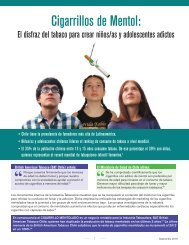Public health successes and missed opportunities
Public-health-successes-and-missed-opportunities-alcohol-mortality-19902014
Public-health-successes-and-missed-opportunities-alcohol-mortality-19902014
You also want an ePaper? Increase the reach of your titles
YUMPU automatically turns print PDFs into web optimized ePapers that Google loves.
MONITORING ALCOHOL EXPOSURE<br />
The key indicator for monitoring harmful alcohol consumption at the country <strong>and</strong> international level is adult (defined<br />
as age 15 years <strong>and</strong> over) per capita consumption (18), which is a composite measure comprising mainly recorded <strong>and</strong><br />
unrecorded consumption. Recorded consumption refers to all alcoholic beverages that are officially registered by the<br />
respective country where they are consumed, most commonly based on taxation (18–20). Unrecorded consumption is a<br />
summary term for all non-registered products, which include the following main categories (21,22): legal but unrecorded<br />
alcohol products (mostly homemade alcohol); alcohol products recorded outside the jurisdiction where they are consumed<br />
(cross-border shopping); surrogate alcohol (non-beverage ethanol-based alcohol products not or not officially intended for<br />
human consumption); <strong>and</strong> illegally produced or smuggled alcohol products intended for human consumption (including<br />
illegal homemade alcohol). With respect to surrogate alcohol, sometimes products may not officially be intended for<br />
human consumption, but in reality they are only declared as such to avoid the higher taxation of officially declared<br />
alcoholic beverages. Ethanol-based medicinal tinctures or perfumes with fragrances would be one such example in the<br />
Russian Federation (23,24).<br />
Globally, unrecorded alcohol has constituted at least 20% of all alcohol consumed in the past decades, but with<br />
high variability between countries <strong>and</strong> regions, <strong>and</strong> over time (25–27). The proportion of unrecorded to total alcohol<br />
consumption is in general associated with economic wealth: the higher the wealth of a country (e.g. as measured by its<br />
gross domestic product [GDP]), the lower the proportion of unrecorded alcohol to overall consumption (1,28). In addition to<br />
recorded <strong>and</strong> unrecorded consumption, tourist consumption is subtracted for a small number of countries where tourists<br />
consume a sizable share of the overall alcohol consumed (see (29) for definitions). For most countries, it is assumed that<br />
tourist consumption is balanced by the consumption of inhabitants while spending time outside of their country.<br />
The objective of this chapter is to describe the long-term adult per capita alcohol consumption 4 for all countries that are<br />
part of the WHO European Region from 1990 onwards. This is the earliest year for which there are systematic estimates<br />
of unrecorded consumption. In addition, it has been the goal to provide estimates of recorded versus unrecorded<br />
consumption, <strong>and</strong> estimates of average consumption per drinker. While some regional trends are included, these will be<br />
used only to illustrate trends for groups of countries with similar drinking levels or drinking patterns. The main emphasis<br />
is on the country level.<br />
Methods for estimating trends in alcohol exposure<br />
DATA<br />
The Global Information System on Alcohol <strong>and</strong> Health (GISAH) (29) has been used for estimates of adult per capita<br />
consumption of alcohol, mostly derived from taxation, or production, import <strong>and</strong> export data (18,19).<br />
Estimates of recorded adult per capita alcohol consumption exist as time series of yearly data since 1960 for all WHO<br />
Member States; these data are regularly updated according to an algorithm based on the validity <strong>and</strong> reliability of sources<br />
(18). For the year 2014, data on recorded adult per capita consumption for the minority of countries without available data<br />
were estimated based on regressions of previous trends for this indicator.<br />
For the time after 1990, there are estimates of unrecorded consumption for select years (1990; 2000; 2010–2014),<br />
mostly assembled by the WHO Collaborating Centre for Mental Health <strong>and</strong> Addiction, Toronto within the WHO monitoring<br />
system on alcohol (for methodology, see (28,30,31)) (see Box 1). The years in between the estimated years were imputed<br />
based on linear interpolation between data points.<br />
4<br />
In the remaining text, adult per capita consumption or alcohol per capita consumption is used as total consumption. Sub-categories will be specified.<br />
2




